National Science Fonudation (NSF) Divison of Mathematical Sciecne (DMS) Project

#1913016:: Fluid-filled Fracture Propagation with a Phase Field Approach in Subsurface
by Employing Nonlinear Strain Limiting Models and Enriched Galerkin Methods
08/01/2019 - 7/31/2021 $99,116.00
Abstract : The project aims to investigate the way in which pressurized and fluid-filled cracks or fractures spread through subsurface materials. In porous materials such as soils and rocks, the flow of the fluids through the material's pores can force significant deformations (such as cracks and fractures) to occur in the solid porous media. These poromechanical interactions are crucial to many important problems such as tunnel construction, subsidence, dam or levee failure, and CO2 sequestration.
The classic mathematical model governing the spread of these deformations is formulated by coupling linear elasticity or poroelasticity with deformation systems. However, one of the major disadvantages of classical linear elasticity models is that strain values are linearly proportional to stress values. Thus, it contradicts the assumptions of the model, and it may not accurately predict realistic scenarios. This project focuses on establishing the nonlinear strain limiting model, a new class of theoretical model. The advantage of the nonlinear strain limiting models over classical linearized models is that strain remains bounded even if the stress tends to infinity, which is critical for fluid-filled fractures. The new model will be extended to consider poroelasticity. Next, the poroelasticity model will be coupled with a phase field approach to implement quasi-static fluid-filled fracture propagation. Moreover, the novel enriched Galerkin (EG) finite element approximations will be employed in the project to address several crucial issues for numerical discretization. It is well known that classical Galerkin finite element methods generally do not guarantee local mass conservation, which could lead to non-physical oscillation. EG methods will be investigated to overcome these challenges, and their stability and convergence for the poroelasticity system will be analyzed. The findings will then be used to develop a forecasting tool to predict the path of quasi-static fracture propagation and will be utilized to evaluate and validate the performance of these new models.
NSF Webpage Click Here
The following journal papers are the outcome of the project for each objectives
Objective 1: Development of Enriched Galerkin methods for related problems
[1] W. Choi, S. Lee, Optimal Error Estimate of Elliptic Problems with Dirac Sources, 2019, Applied Numerical Mathematics, Volume 150, April 2020, Pages 76-104.❀ Link to the journal
❀ Abstract: We present an optimal a priori error estimates of the elliptic problems with Dirac sources away from the singular point using discontinuous and enriched Galerkin finite element methods. It is widely shown that the finite element solutions for elliptic problems with Dirac source terms converge sub-optimally in classical norms on uniform meshes. However, here we employ inductive estimates and norm to obtain the optimal order by excluding the small ball regions with the singularities for both two and three dimensional domains. Numerical examples are presented to substantiate our theoretical results.
➪ Highlights :
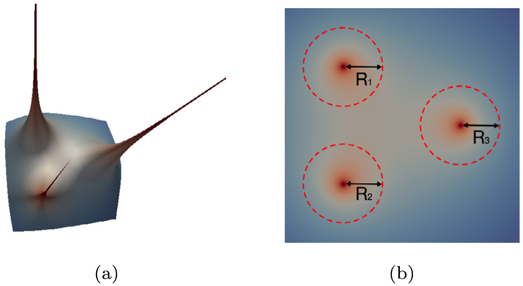
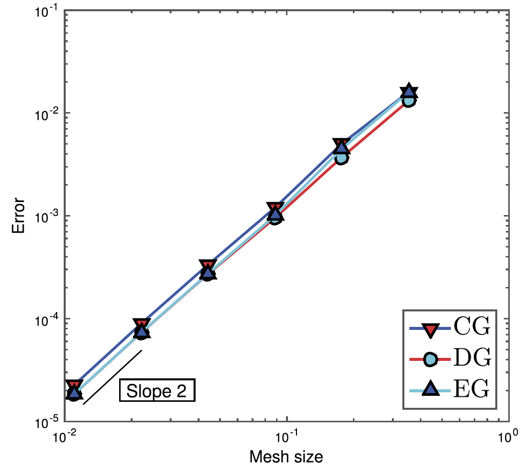
[2] T. Kadeethum, H.M. Nick, S. Lee, F. Ballarin Enriched Galerkin Discretization for Mixed-Dimensional Modelling Flow in Fractured Porous Media, Advances in Water Resources, Volume 142, August 2020, 103620.
❀ Link to the journal
❀ Abstrct: This paper presents the enriched Galerkin discretization for modeling fluid flow in fractured porous media using the mixed-dimensional approach. The proposed method has been tested against published benchmarks. Since fracture and porous media discontinuities can significantly influence single- and multi-phase fluid flow, the heterogeneous and anisotropic matrix permeability setting is utilized to assess the enriched Galerkin performance in handling the discontinuity within the matrix domain and between the matrix and fracture domains. Our results illustrate that the enriched Galerkin method has the same advantages as the discontinuous Galerkin method; for example, it conserves local and global fluid mass, captures the pressure discontinuity, and provides the optimal error convergence rate. However, the enriched Galerkin method requires much fewer degrees of freedom than the discontinuous Galerkin method in its classical form. The pressure solutions produced by both methods are similar regardless of the conductive or non-conductive fractures or heterogeneity in matrix permeability. This analysis shows that the enriched Galerkin scheme reduces the computational costs while offering the same accuracy as the discontinuous Galerkin so that it can be applied for large-scale flow problems. Furthermore, the results of a time-dependent problem for a three-dimensional geometry reveal the value of correctly capturing the discontinuities as barriers or highly-conductive fractures.
➪ Highlights :
- A novel mixed-dimensional enriched Galerkin presented for fluid flow in fractured porous media
- Enriched Galerkin provides accurate solutions capturing discontinuities with coarse meshes
- Positive aspects of the enriched Galerkin with mixed-dimensional paradigm highlighted
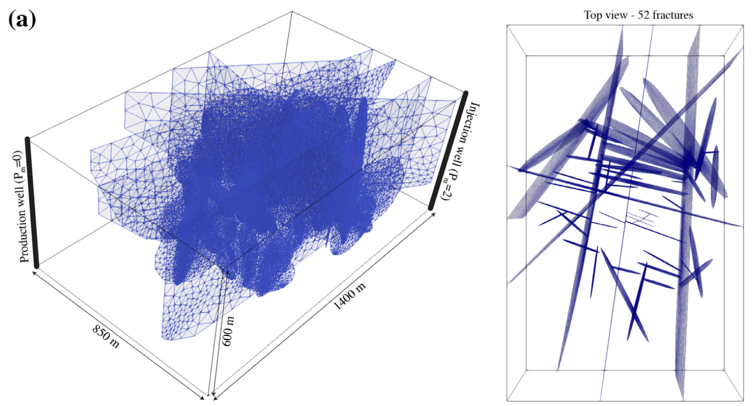
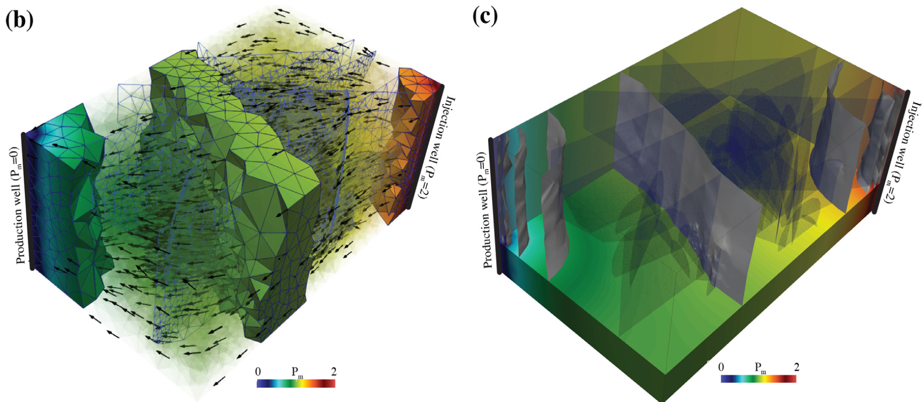
[3] Rupp, A., Lee, S. Continuous Galerkin and Enriched Galerkin Methods with Arbitrary Order Discontinuous Trial Functions for the Elliptic and Parabolic Problems with Jump Conditions. J Sci Comput 84, 9 (2020)
❀ Link to the journal
❀ Abstract: In this paper, a new version of the enriched Galerkin (EG) method for elliptic and parabolic equations is presented and analyzed, which is capable of dealing with a jump condition along a submanifold \Gamma_LG. The jump condition is known as Henry's law in a stationary diffusion process. Here, the novel EG finite element method is constructed by enriching the continuous Galerkin finite element space by not only piecewise constants but also with piecewise polynomials with an arbitrary order. In addition, we extend the proposed method to consider new versions of a continuous Galerkin (CG) and a discontinuous Galerkin (DG) finite element method. The presented uniform analyses for CG, DG, and EG account for a spatially and temporally varying diffusion tensor which is also allowed to have a jump at \Gamma_LG and gives optimal convergence results. Several numerical experiments verify the presented analyses and illustrate the capability of the proposed methods.
➪ Highlights :

[4] T. Kadeethum, H.M. Nick, S. Lee, F. Ballarin, Enriched Galerkin Discretization for Modelling Poroelasticity and Permeability Alteration in Heterogeneous Porous Media, submitted, 2019
[5] T. Kadeethum, S. Lee, H.M. Nick, Finite Element Solvers for Biot's Poroelasticity Equations in Porous Media, submitted, 2019
[6] T. Kadeetuhm, S.Lee, F. Ballarin, J. Choo, H.M. Nick A Locally Conservative Finite Element Framework for Coupled Hydro-Mechanical-Chemical Processes in Heterogeneous Porous Media
Objective 2: Advanced Phase-Field Fracture Propagation
[7] S. Lee, M. F. Wheeler, Modeling interactions of natural and two phase fluid filled fracture propagation in porous media, Computational Geoscience, DOI: 10.1007/s10596-020-09975-0, 2020❀ Link to the journal
❀ Abstract: In this paper, a novel computational framework is introduced for simulation of multiphase flow, geomechanics, and fracture propagation in porous media based on Biot's model for poroelasticity by focusing on interactions between hydraulic and natural fractures. Since realistic porous media contain many natural fractures, it is important not only to stimulate hydraulic fractures but also to study the interaction between natural and hydraulic fractures. Here, state-of-the-art numerical modeling of natural and hydraulic fractures using a diffusive adaptive finite element phase field approach is employed. The locally mass conservative enriched Galerkin finite element methods (EG) are utilized to model two-phase flow in propagating fractures with relative permeability and capillary pressure. Geomechanics approximated by a continuous Galerkin finite element method is coupled to multiphase flow by applying an iteratively coupled scheme. Numerical examples are presented that demonstrate the effectiveness of this framework for different propagation scenarios by varying the degrees of physics. In addition, the capabilities to perform high-fidelity simulations on complex fracture networks, with randomly joined diffusive natural fractures, are illustrated.
➪ Highlights :
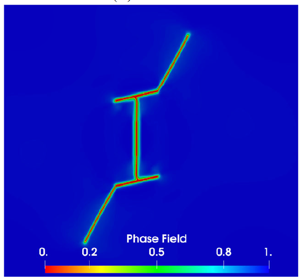
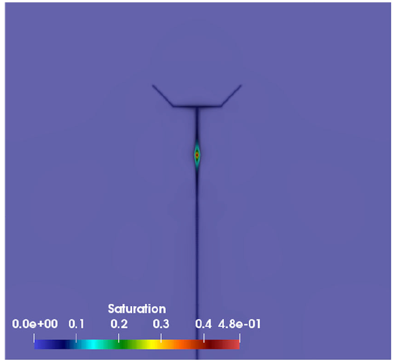
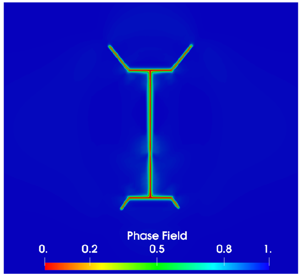
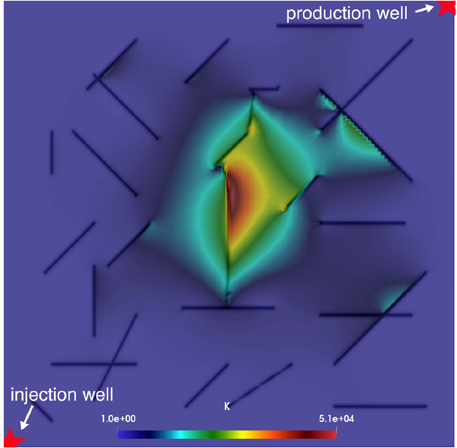
[8] M.F. Wheeler, T. Wick, S. Lee IPACS: Integrated Phase-Field Advanced Crack Propagation Simulator. An adaptive, parallel, physics-based-discretization phase-field framework for fracture propagation in porous media, Computer Methods in Applied Mechanics and Engineering, Volume 367, 1 August 2020, 113124
❀ Link to the journal
❀ Abstract: In this work, we review and describe our computational framework for solving multiphysics phase-field fracture problems in porous media. Therein, the following five coupled nonlinear physical models are addressed: displacements (geo-mechanics), a phase-field variable to indicate the fracture position, a pressure equation (to describe flow), a proppant concentration equation, and/or a saturation equation for two-phase fracture flow, and finally a finite element crack width problem. The overall coupled problem is solved with a staggered solution approach, known in subsurface modeling as the fixed-stress iteration. A main focus is on physics-based discretizations. Galerkin finite elements are employed for the displacement-phase-field system and the crack width problem. Enriched Galerkin formulations are used for the pressure equation. Further enrichments using entropy-vanishing viscosity are employed for the proppant and/or saturation equations. A robust and efficient quasi-monolithic semi-smooth Newton solver, local mesh adaptivity, and parallel implementations allow for competitive timings in terms of the computational cost. Our framework can treat two- and three-dimensional realistic field and laboratory examples. The resulting program is an in-house code named IPACS (Integrated Phase-field Advanced Crack Propagation Simulator) and is based on the finite element library deal.II. Representative numerical examples are included in this document.
➪ Highlights :
- A software framework IPACS to simulate multiphysics phase-field fracture propagation in porous media.
- Physics-based finite element discretizations and solvers for the coupled system
- Iterative coupling methods and linear solvers.
- Various applications considering realistic scenarios from laboratory scales to field scales.
Objective 3: Nonlinear Strain Limiting Coupeld with Phase-Field Fracture Propagation
[9] S. Lee, S.M. Mallikarjunaiah, H. Yoon, Nonlinear strain-limiting Elasticity for Fracture Propagation with Phase-Field Approach, Submitted 2020[10] H.Yoon, S. Lee, S.M. Mallikarjunaiah, Quasi-Static Anti-Plane Shear Crack Propagation in a New Class of Nonlinear Strain-Limiting Elastic Solids using Phase-Field Regularization, Submitted 2020
Supported Confernece Presentations
All of the below conferences are delayed or canceled due to Covid-19 pandemic
● [14th-15th Mar 2020] The 44th SIAM Southeastern Atlantic Section Conference (link), Auburn University, USA● [11th-13th May 2020] The 50th John H. Barrett Memorial Lectures, A3N2M: Approximation, Applications, and Analysis of Nonlocal, Nonlinear Models, (link), The University of Tennessee, Knoxville, USA
● [21st-25th Jun 2020] Computational Methods in Water Resources XXIII (CMWR) 2020 (link), Stanford University, USA
● [19th-24th July 2020] WCCM & ECCOMAS Congress 2020, Paris, France (link)
The Math Fun Day Event
The Department of Mathematics annually hosts FSU Math Fun, a joint Open House for the general public, including K-12 students and teachers. Come join us for some math fun! There will be lots of hands-on activities, presentations, exhibits, demonstration, and workshops. Activities are available for all ages in grades K-12, but students in kindergarten and grade 1 will need extra parental help. Anyone and everyone is invited to attend and all the activities are free.
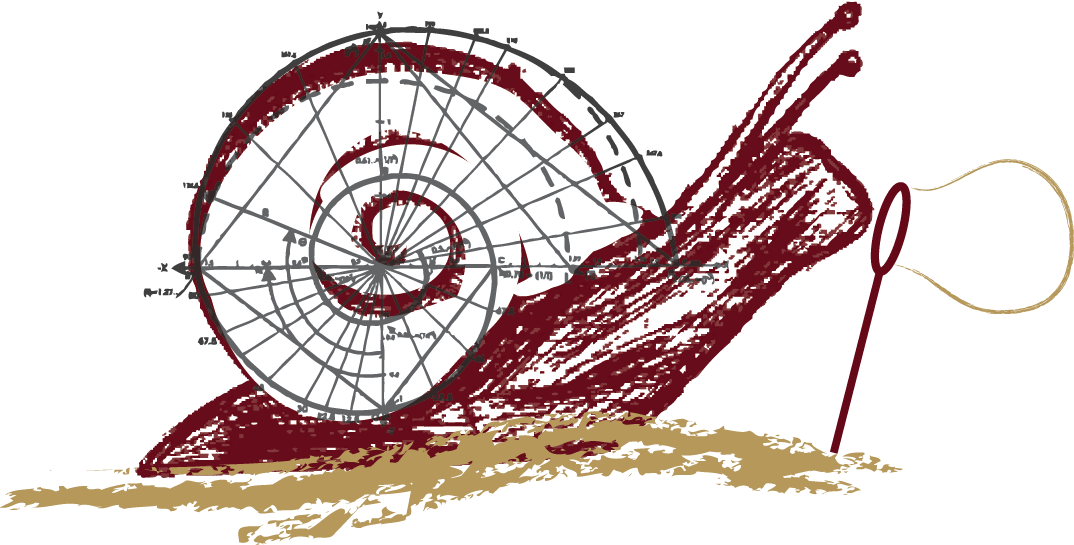 Click for more information!
Click for more information!

